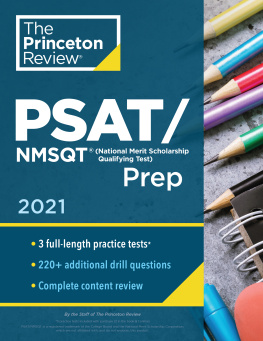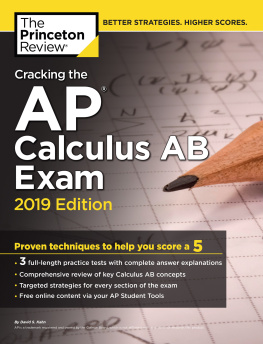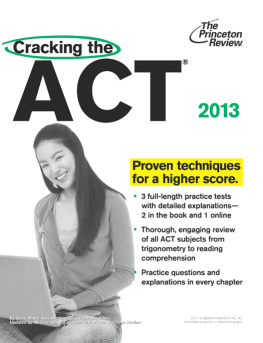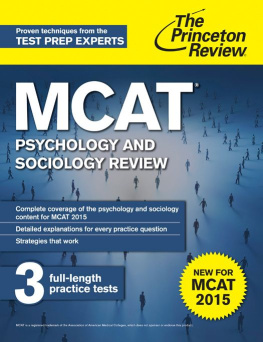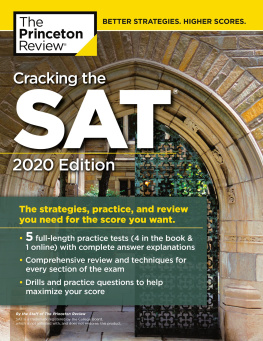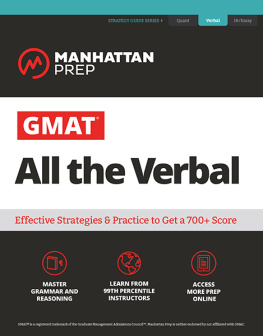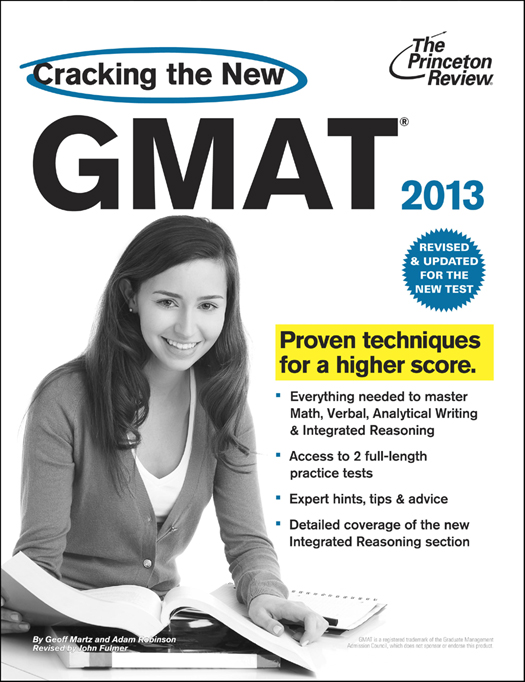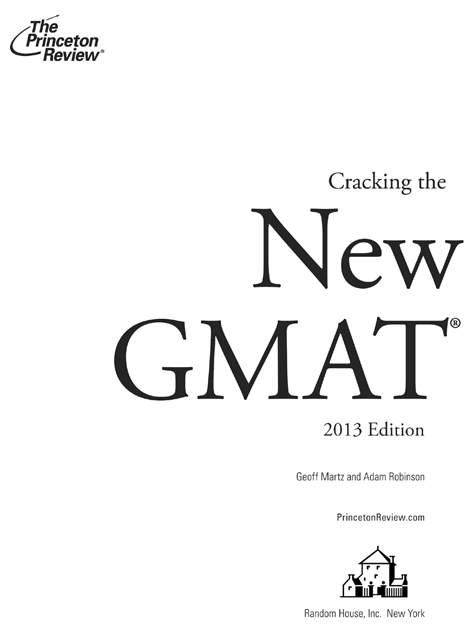
Editorial
Rob Franek, VP Test Prep Books, Publisher
Seamus Mullarkey, Editorial Director
Laura Braswell, Senior Editor
Calvin Cato, Editor
Selena Coppock, Editor
Meave Shelton, Editor
Random House Publishing Team
Tom Russell, Publisher
Nicole Benhabib, Publishing Manager
Ellen L. Reed, Production Manager
Alison Stoltzfus, Associate Managing Editor
The Princeton Review, Inc.
111 Speen Street, Suite 550
Framingham, MA 01701
E-mail:
Copyright 2012 by The Princeton Review, Inc.
The Princeton Review is not affiliated with Princeton University.
All rights reserved. Published in the United States by Random House, Inc., New York, and in Canada by Random House of Canada Limited, Toronto.
Terms of Service: The Princeton Review Online Companion Tools (Online Companion Tools) for the Cracking book series and 11 Practice Tests for the SAT & PSAT are available for the two most recent editions of each book title. Online Companion Tools may be activated only once per eligible book purchased. Activation of Online Companion Tools more than once per book is in direct violation of these Terms of Service and may result in discontinuation of access to Online Companion Tools services.
eISBN: 978-0-307-94462-7
Editor: Selena Coppock
Production Editor: Kristen Harding
Production Coordinator: Deborah A. Silvestrini
2013 Edition
v3.1
Contents
Acknowledgments
Our GMAT course is much more than clever techniques and powerful computer score reports; the reason our results are great is that our teachers care so much about their students. Thanks to all the teachers who have made the GMAT course so successful, but in particular the core group of teachers and development people who helped get it off the ground: Alicia Ernst, Tom Meltzer, Paul Foglino, John Sheehan, Mark Sawula, Nell Goddin, Teresa Connelly, and Phillip Yee.
Special thanks to GMAT guru, John Fulmer, for his tireless work updating all of the books in the TPR GMAT suite for the new version of the GMAT.
Special thanks to Adam Robinson, who conceived of and perfected the Joe Bloggs approach to standardized tests and many of the other successful techniques used by The Princeton Review.
Foreword
Im glad you bought this book.
Primarily Im glad because youve probably heard good things about The Princeton Review. Our tutors and teachers are carefully chosen and supported, and our tutoring and classroom courses continue to produce unmatched gains in GMAT scores. And we attract people like Geoff Martz, who is one of the most insightful and articulate instructors Ive met, to make sure this book reflects everything weve learned about the test and the best ways to prepare for it.
Im also glad because it means youre going to raise your GMAT score, and youre going to do it without memorizing dozens of math theorems or the complete rules of English grammar. The information needed to do well on this test is surprisingly limited, and well concentrate on a small number of crucial concepts.
Students who feel that their standardized test scores do not reflect their college grades or business acumen probably suspect that theres more to mastering one of these tests than just honing rusty math and verbal skills. At their root, these tests are trying to measure your IQ. They do so with an array of tricks, many of which lead you to wrong answers (called, fittingly, distracters). Some of our techniques address those tricks; I think youll find them fun and useful on every standardized test you take.
Despite Geoffs great skill, this book cant mold itself around your strengths and weaknesses as effectively as our instructors or online programs. For this reason, weve created supplementary online tools that you can access at PrincetonReview.com. Using the online exams, we can help you spend your time more wisely to achieve the best results possible.
So good luck on the New GMAT! And if you need more help, or just want to find the right business school or the best way to pay for it, please stop by PrincetonReview.com/mba or call us at 800-2REVIEW (international students should call 1-212-874-8282).
John Katzman
Founder

More Practice
- Practice your GMAT test-taking skills.
- Access two full length practice GMAT exams.
- Take one as a diagnostic test before you work through Cracking the New GMAT.
- Work through the chapters and practice questions found in this book, focusing on the sections where you need specific review.
- Then take the second practice GMAT and see how much you improved.
- Review all of the content to sharpen your skills one last time.
- Then, prepare to tackle the new GMAT with skill and ease!
Register your book now!
- Go to www.PrincetonReview.com/cracking
- Youll see a welcome page where you should register your book using the ISBN. You can look at the ISBN on the easily.
- Now youre good to go!
Part I
Orientation
Chapter 1
Introduction
Congratulations on your decision to attend business school! Preparing for the New GMAT is an important part of the process, so lets get started. This chapter will provide you with a strategic plan for acing the New GMAT, as well as an overview of the test itself, including question formats and information on how the test is scored.
HOW TO USE THIS BOOK: A STRATEGIC PLAN FOR ACING THE NEW GMAT
1. Learn the Famed Princeton Review Test-Taking Strategies
In the next few chapters, youll find the strategies that have given our GMAT students the edge for the past 20 years.
2. Learn the Specific Math and Verbal Skills Youll Need
Our courses include an extremely thorough review of the math and verbal skills our students need to ace the GMAT, and this book will give you that same review.
Important Phone
Numbers:
To register for the GMAT:
800-717-GMAT
To reach GMAC Customer
Service: 866-505-6559 or
703-245-4222
3. Practice Each Type of Questionat the Difficulty Level You Need to Master
Two of the GMATs sections, the Quantitative and Verbal sections, are computer adaptive. These sections quickly hone in on your ability level and then mostly give you questions at or just above that level. It makes sense for you to practice on the level of problem you will actually see during the test. Cracking the New GMAT is the only book out there with practice questions grouped by difficulty. Page after page of practice questions are arranged at the back of this book in difficulty binsjust like the questions on the real GMATso that you can concentrate on the question level you will have to answer on the actual test in order to get the score you need.
The new Integrated Reasoning section of the GMAT is not computer adaptive. Weve provided two complete Integrated Reasoning sections at the back of this book to help you prepare for this section of the test.


